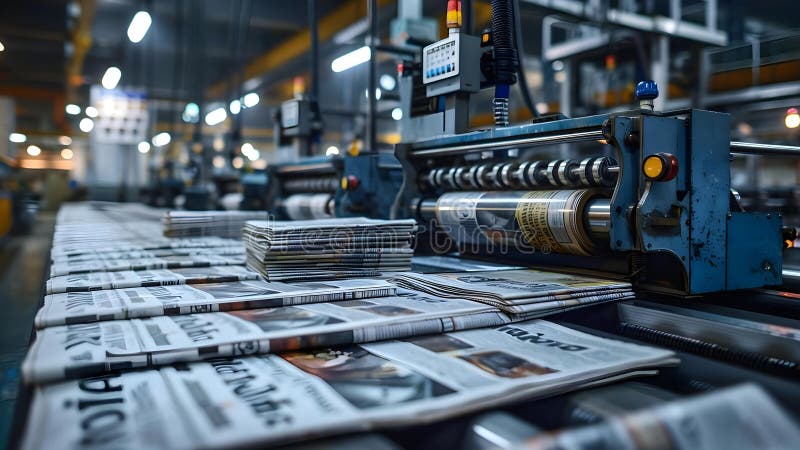In today’s fast-paced printing world, automation in modern offset presses is revolutionizing the way printing operations are conducted. This transformation is particularly significant for marketing professionals who rely on the efficiency and quality of printed materials. By integrating advanced automation technologies, offset presses are now capable of delivering unmatched precision and speed, making them indispensable in the printing industry.

The Evolution of Offset Printing
Offset printing has long been a staple in the printing industry, known for its high-quality output and cost-effectiveness for large print runs. Over the years, the integration of automation has drastically improved the overall efficiency and consistency of offset presses. This evolution has paved the way for modern printing solutions that cater to the diverse needs of businesses and individuals alike.
Key Benefits of Automation in Offset Presses
1. Enhanced Production Speed
One of the primary advantages of automation in offset presses is the significant increase in production speed. Automated systems streamline the printing process, reducing setup times and minimizing human intervention. This acceleration allows printing companies to meet tight deadlines and handle larger volumes of work.
2. Improved Print Quality
Automation ensures consistent and precise print quality by reducing human errors and maintaining optimal press settings throughout the process. This results in sharper images, vibrant colors, and accurate reproduction of intricate details, which are crucial for marketing materials and publications.
3. Cost Efficiency
By minimizing manual labor and reducing waste, automation significantly cuts down on operational costs. The precise control over ink usage and paper handling further contributes to cost savings, making offset printing a more economical choice for businesses.
4. Flexibility and Adaptability
Modern automated offset presses are designed to handle a wide range of printing tasks, from small-scale projects to large commercial runs. This flexibility allows printing companies to cater to diverse client needs, offering customized solutions and quick turnarounds.
Automation Technologies in Modern Offset Presses
1. Computer-to-Plate (CTP) Systems
CTP technology eliminates the need for traditional film-based plate-making processes, streamlining the workflow and improving accuracy. By directly transferring digital files to printing plates, CTP systems enhance the efficiency and precision of the printing process.
2. Automated Ink Control
Advanced ink control systems monitor and adjust ink flow in real-time, ensuring consistent color output throughout the print run. This technology minimizes color variations and optimizes ink usage, reducing waste and enhancing print quality.
3. Inline Quality Control Systems
Inline quality control systems use sensors and cameras to continuously monitor print quality during production. Any deviations are instantly detected and corrected, ensuring the final output meets the highest standards of accuracy and consistency.
4. Automated Paper Handling
Automated paper handling systems streamline the feeding, alignment, and trimming of paper, reducing manual intervention and minimizing errors. This automation enhances productivity and minimizes the risk of paper jams or misalignments.
Challenges and Future Prospects
While automation in offset presses offers numerous benefits, it also presents challenges. The initial investment in automated systems can be substantial, and the integration process may require skilled technical expertise. However, the long-term advantages of increased efficiency, reduced costs, and improved quality make automation a worthwhile investment.
The Future of Offset Printing
As automation technologies continue to evolve, the future of offset printing looks promising. Innovations such as AI-driven press controls and IoT connectivity are expected to further enhance the capabilities of offset presses, offering unprecedented levels of efficiency and customization.
Resources for Further Reading
To learn more about the intricacies of offset printing, you can explore this comprehensive guide. Additionally, understanding the differences between printing methods can help you make informed decisions regarding your printing needs.
Conclusion
In conclusion, automation in modern offset presses is reshaping the printing landscape by delivering speed, precision, and cost-efficiency. As technology continues to advance, the opportunities for innovation in offset printing are boundless, making it an exciting time for marketing professionals and printing businesses alike.

FAQ Section
1. What is the impact of automation on offset printing costs?
Automation reduces costs by minimizing manual labor, reducing waste, and optimizing resource usage, making offset printing more economical.
2. How does automation improve print quality?
Automation ensures consistent settings and real-time adjustments, leading to sharper images, vibrant colors, and accurate details.
3. What challenges do businesses face with automation in offset presses?
The primary challenges include the initial investment and the need for skilled technical expertise for system integration.
For more insights into offset printing, visit offset vs. laser printing and explore offset printing for magazines.
This article contains affiliate links. We may earn a commission at no extra cost to you.






